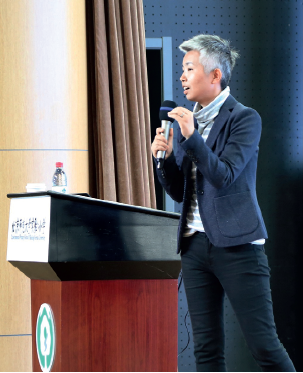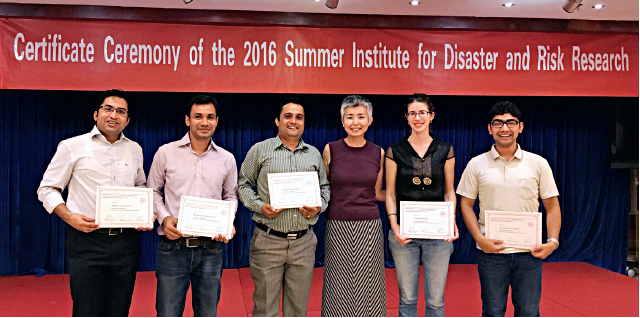Protecting People from Natural Disasters
By special correspondent ZHANG LI
IT is not easy to predict natural hazards. The situation is especially complex in China as there are many types of natural hazards occurring in places with different geographical conditions, which makes the disaster prevention and reduction efforts more difficult.
To reduce the impact of natural disasters, Chinese scholars and experts are taking action. They are studying previous natural disasters and assessing the risk. Their research results are valuable information from which the Chinese government can make informed decisions. Professor Yang Saini, from the Academy of Disaster Reduction and Emergency Management (ADREM) at Beijing Normal University, is one of them.
A Career in the Science of Disasters
Born in 1975, Yang began studying at Southeast University in Nanjing in 1993, where she completed her undergraduate degree and Masters. In 2000, she went to the University of Maryland, where she got her PhD degree. In 2006, she got a tenure-track position at Cleveland State University.

“My life was stable in the U.S. However, I felt I didn’t want to settle into a routine,” Yang recalled with a smile on her face.
In 2008, Beijing Normal University offered Yang a job and she accepted the invitation to join its National Key Laboratory of Earth Surface Processes and Resource Ecology. “I wanted to do something meaningful,” she explained about how she made the decision.
Professor Yang studied bridge engineering during her undergraduate years, then traffic engineering for her Masters and civil engineering for her doctoral program. Therefore, she boasts interdisciplinary expertise.
After returning to China, Yang joined the ADREM, which focuses on scientific research into natural disasters, natural resources and global climate change, and cultivates experts in those areas. That was how Yang launched a career in the science of disasters.
Supporting Decision-Making
Yang is mainly engaged in infrastructure risk assessment and management, and community-based disaster risk reduction.
She has been in charge of some national level projects. One of them was under the National Science Foundation of China, studying the cascade effect on a region by multiple natural disasters. Another example is a research project Yang led under the National Basic Research Program (also known as 973 Program), looking at the relationship between global change and environmental risks. She and her team members made great achievements in assessing the risk of infrastructure when a disaster strikes and applying relevant modeling.
Heavy rainfall hit Beijing on July 21, 2012. Yang, by utilizing a disaster impact analysis model created by her team, created a simulation of the scenario with the flooded streets and inadequate drainage systems. The model accurately showed the changes in traffic flow over the transport network throughout the whole process.
“Our research provides a theoretical basis for investing in resilient infrastructure,” said Yang.
Another of Yang’s stand-out achievements was to establish a model assessing the risks posed to the infrastructure network during natural disasters. Yang and her team analyzed the typhoon data from the past 60 years in Hainan Province. By creating a typhoon model, including the typhoon’s characteristics, landing position and its size, Yang’s team conducted research into the typhoon’s impact on road functions and road transport, in order to make alternative emergency response plans.
“A good emergency response plan should be able to serve different parties,” Yang explained. “For example, drivers can quickly know about possible traffic conditions during the disaster and choose the right way to go. The traffic management department can make plans in advance as they can predict the loss of transport capacities. A good emergency response plan can also guide emergency response, helping the decision-makers decide which sections of road should be fixed immediately and which sections can be set aside and dealt with later.”

As the society and economy continues to develop and people’s living conditions improve, it becomes increasingly necessary to address community-based disaster prevention and mitigation. Over the past few years, Yang has launched surveys and studies in communities and provided training to residents on how to create and use risk maps. “Our aim is to let people know where is safe and where is dangerous, and where the evacuation routes are when disasters strike,” explained Yang.
Their research provides a theoretical basis for governments at various levels to make decisions when choosing locations for emergency shelters and planning for evacuation routes.
The Spirit of Giving
In recent years, China has made great progress in disaster prevention, reduction and relief, and has accumulated valuable experience when dealing with large-scale natural disasters. In December 2016, the Chinese government issued its “Opinions on Promoting Reform to the System and Mechanism of Disaster Prevention, Mitigation and Relief,” as well as the “National Comprehensive Plan for Disaster Prevention and Mitigation (2016-2020).” However, it is clear that China still faces a daunting situation when dealing with various types of natural disasters.
“Our mechanism should be further improved, but another problem is that our people’s awareness of disaster prevention is still weak and they don’t know how to help each other during disasters,” Yang pointed out.
She often goes to remote areas frequently hit by natural disasters to conduct investigations and research, and she found that people rely heavily on the government during disaster relief, and they are not aware that they can help themselves when disasters strike. “Many people don’t know about the fact that after an earthquake, most survivors are saved through their own efforts or help by other victims,” said Yang.
Meanwhile, what also worries Yang is that government officials often focus more on disaster relief rather than disaster prevention, as it is difficult to see the benefits of making an investment before disasters actually occur. Yang’s team is working on building models to show that investment in disaster prevention can effectively reduce risks. That is to say, through the model, people can see the benefits of disaster prevention measures clearly.
Yang said frankly that the task of training community residents to help enhance awareness of disaster prevention and participate in community-based disaster relief work is not always well-recognized. “Because after all this effort we may not be able to write an academic paper; we may not be able to win support from national programs, and it is difficult to evaluate the effectiveness of our work. But I believe we should have the spirit of giving. Scholars should play their parts to serve the society,” said Yang.
Yang said that she hopes the media can help publicize more information about disaster risk reduction, teach people how to save themselves and help other victims when disasters hit and enhance their awareness of natural hazards. Through years of practice, Yang and her team members found that it is difficult to help elderly people in remote areas with a low level of education to learn and accept new information, so they now focus on students in elementary and middle schools, and let the young influence their parents.
International Cooperation
The International Center for Collaborative Research on Disaster Risk Reduction was established at Beijing Normal University at the end of 2015. Having established partnership with the U.K., Bangladesh and Nepal, it is committed to promoting collaborative research in core technologies and cutting-edge topics aimed at reducing disaster risks, strengthening academic ties in South-South cooperation, and helping other developing countries such as Nepal and Bangladesh. Yang was appointed director of the center.
“We plan to establish a network for international collaborative research into disaster risk reduction, building a platform for global research institutions engaged in disaster risk reduction, emergency management and post-disaster rebuilding to communicate and learn from each other,” said Yang.
According to Yang, since the center was established, a series of cooperation projects have been carried out. Yang said that she found that cooperation is never just about technology and products. The key is to understand the needs of partners and reach a consensus through extensive consultation; therefore, an effective cooperation mechanism should be established.
- The Belt and Road Initiative Promises Huge Cooperation Space for China and Vietnam – Interview with the Chinese Ambassador to Vietnam, Hong Xiaoyong
- Atlas Design: Giving New Life to Chinese Crafts
- Norman Bethune: Doctor of the Revolution
- Jean Michel’s Artistic Journey in China
- The Globalization Pace of Confucius Institutes
Services
Economy
- BRICS Welcomes Its Second Decade
- Forging a “Two-Wheel Drive” for Sino-U.S. Economic and Trade Relations
- Tong Ren Tang: Envoy of Traditional Chinese Medicine
- Chinese Manufacturing Sector Rides Fourth Industrial Revolution Wave
- China, Sri Lanka Strengthen Cooperation on Maritime Silk Road Interview with Sri Lankan Ambassador to China Karunasena Kodituwakku
